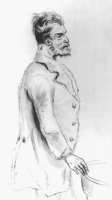 | Back to e-WV
| Back to e-WV
 The West Virginia Encyclopedia
The West Virginia Encyclopedia
 | Back to e-WV
| Back to e-WV
 The West Virginia Encyclopedia
The West Virginia Encyclopedia

From the 1830s through the Civil War, abolitionists worked to emancipate all slaves within the United States. During the religious movement known as the Second Great Awakening, evangelical Christianity gained popular appeal in the Northern states, calling for an end to sinful practices and perpetuating a vision of a better human society. Such could not be achieved, claimed some evangelicals, in a country that tolerated slavery. As the size of the United States greatly expanded during the mid-1800s, the debate over slavery in the new territories helped turn this religious movement into a moral and political crusade.
In what is now West Virginia, abolitionists quietly fought this crusade in the early decades of the movement. The debate quickened as the Civil War approached. In 1857 the town of Ceredo, on the banks of the Ohio River in Wayne County was founded by northern abolitionists led by Eli Thayer. The townspeople helped fugitive slaves slip across the river where they might find sanctuary at nearby Quaker Bottom (later Proctorville), Ohio, and eventually find safe passage to Canada. Z. D. Ramsdell was another prominent Ceredo abolitionist who allegedly helped fugitives in the same capacity.
Historical evidence suggests that the majority of Western Virginians supported the emancipation of slaves. The different viewpoints between Eastern and Western Virginia were due largely to the contrasting economic and social developments of the regions. Slave-based agriculture did not thrive on the rugged farms and in the colder climate of Western Virginia. Many Western Virginians had little contact with slavery, and the religious denominations of the many Scotch-Irish and German settlers of Western Virginia typically condemned the institution. In Eastern Virginia, the economic ties with slavery were too strong to allow for any sizable abolitionist sentiment.
Yet Western Virginians generally opposed extreme abolitionism. Perhaps the best example of the Western Virginian view on slavery comes from the ‘‘Ruffner Pamphlet,’’ published in 1847. Henry Ruffner of Kanawha County proposed gradual emancipation and attacked slavery on economic, rather than moral, grounds. This moderate viewpoint claimed, ‘‘Slavery is demonstrated to be not only unprofitable, but deeply injurious to the public prosperity.’’
Although most Western Virginians supported Ruffner’s moderate approach, the most famous example of radical abolitionism in America occurred in Western Virginia, pushing the boundaries of antislavery radicalism. John Brown, attempting to incite a slave rebellion, seized the federal arsenal at Harpers Ferry on October 16, 1859. After the attempted uprising failed, Brown was tried and hanged for treason. John Brown’s raid sharpened the already strong divisions between North and South, leading the nation ever closer to Civil War.
During the Civil War, prominent Western Virginians became more outspoken against slavery as the statehood movement grew. At the West Virginia Constitutional Convention, the issue of emancipation was hotly debated. Among those calling for emancipation were Robert Hager, Granville Parker, and Gordon Battelle. Others such as Waitman T. Willey and Chester Hubbard were willing to accept emancipation but did not press the issue. Those who opposed the abolitionists included John J. Jackson, John J. Davis, John S. Carlile, and Sherrard Clemens.
Abraham Lincoln and the Congress refused to grant statehood unless an emancipation clause was added to the new state constitution. In February 1863, Willey proposed an amendment to the state constitution that mandated that all slaves under 21 years old as of July 4, 1863, would be freed upon reaching that age. After the approval of the Willey Amendment, the voters of Western Virginia ratified the constitution by a vote of 28,321 to 572. Thus, abolitionism within the statehood movement proved significant in the formation of West Virginia.
Written by C. Belmont Keeney